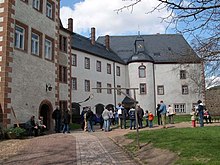Mildenstein Castle
| Mildenstein Castle | ||
|---|---|---|
|
Mildenstein Castle above the Mulde |
||
| Alternative name (s): | Leisnig Castle | |
| Creation time : | 900 to 1000 | |
| Castle type : | Höhenburg, spur location | |
| Conservation status: | Received or received substantial parts | |
| Standing position : | King, count, prince | |
| Place: | Quietly | |
| Geographical location | 51 ° 9 '44.4 " N , 12 ° 55' 31.8" E | |
|
|
||
The Castle Mildenstein earlier, also the castle Mildenstein or castle Leisnig called, is located in Leisnig in mittelsachsen in the Free State of Saxony . Mildenstein Castle is owned by the Free State of Saxony and is managed by the state enterprise " State Palaces, Castles and Gardens of Saxony ".
location
The Spornburg lies on a spur above the Freiberg Mulde . In the high Middle Ages it was always called Leisnig Castle; Only since the end of the 14th century has it been referred to as Mildenstein Castle (after an older castle complex that was destroyed in 1232).
history
Even before the castle was built, the spur over the Freiberg Mulde was settled in prehistoric times. The castle was built as an imperial castle in the 10th century and is one of the oldest castles in the Saxon settlement areas, together with the Meißner Burgberg and Altenburg Castle . It was first found in 1046 as part of the Burgward organization in the German trademark area in the deed of gift of Burgwarde Colditz , Rochlitz and Leisnig by Emperor Heinrich III. to mention his consort Agnes of Poitou . In 1084, the subsequent Emperor Heinrich IV. Awarded the castle to his servant Wiprecht von Groitzsch, who was established in the old settlement area . The Romanesque castle chapel, the oldest preserved building in the castle, also dates from around 1100.
When Wiprecht's granddaughter Mathilde (Mechthild) married Rapoto von Abenberg , Mildenstein Castle came to this Franconian count in 1143. He sold it to Duke Friedrich III in 1148. von Swabia, the later Emperor Friedrich I (Barbarossa) , who converted it again into imperial property in 1158 . Since then it has been a rulership center of the Pleißenland . Barbarossa then gave the castle and accessories as a fief to the Burgraves of Leisnig . In 1188 the emperor himself registered in Leisnig. In his time the chapel was rebuilt and the keep was built in the inner courtyard (last third of the 12th century). At the bottom it consists of mighty ashlar stones as they are typical for this time, at the top it is made of painted bricks, clean and without quarry stone compound, as was common in the 14th century. The old high entrance is 13 meters above the courtyard and was only accessible via ladders, rope ladders or a drop-off wooden staircase. The current gate also dates from the late 12th / early 13th century. The keep in the outer bailey was built in the first half of the 13th century, and the chapel was expanded to include the Gothic choir between 1400 and 1420.
The Burgraves of Leisnig were at times among the most powerful rulers in the Muldenland, but in the 14th century they were subject to the up-and-coming Margraves of Meißen , who conquered the castle in 1365 and forced the Burgraves to sell their burgraviate. At the end of the 14th century, under Margrave Wilhelm I , the castle was fundamentally rebuilt for representative purposes - the granary , manor house and page house were built - similar to Rochlitz Castle , but never used as a residence and remained relatively insignificant as the Wettin official residence ( Leisnig Office ).
In 1706/07, the Polish rival king to Augustus the Strong , Stanislaw Leszczynski , temporarily chose Mildenstein Castle as his residence, while his Swedish allies kept the electorate occupied. In the 18th and 19th centuries, the castle housed the district court, prison and officials' apartments. From 1798 the Mirus family laid out a romantic park around the castle hill, the most important part of which is the high-quality ruin architecture with a rock tunnel from 1866.
In 1890 the castle began to be used as a museum by the Leisniger History and Antiquity Association. The castle's museum houses the Döbelner giant boot, which, with a height of 3.70 m, was the largest boot in the world until 1996. On the occasion of the 950th anniversary of the city of Leisnig, two shoemakers from Leisnig made a 4.90 m high giant boot , which even surpassed the previously largest example.
In 1990 the Heimattierpark created in the castle grounds was closed. The knight's hall was reconstructed. The 32 meter high donjon in the inner courtyard can be climbed as a viewing tower and offers a good view of Leisnig and the Mulde valley.
photos
Front lock - knight's hall
The (first) Döbelner giant boot
Web links
Individual evidence
- ^ The Burggrafschaft Leisnig in the description by Manfred Hiebl
- ↑ Experience Mildenstein Castle: The tour> The keep on the Mildenstein Castle website













